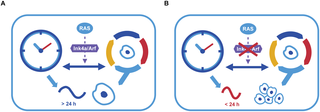PLOS Biology ( IF 7.8 ) Pub Date : 2017-12-07 , DOI: 10.1371/journal.pbio.2002940 Rukeia El-Athman , Nikolai N. Genov , Jeannine Mazuch , Kaiyang Zhang , Yong Yu , Luise Fuhr , Mónica Abreu , Yin Li , Thomas Wallach , Achim Kramer , Clemens A. Schmitt , Angela Relógio

|
The mammalian circadian clock and the cell cycle are two major biological oscillators whose coupling influences cell fate decisions. In the present study, we use a model-driven experimental approach to investigate the interplay between clock and cell cycle components and the dysregulatory effects of RAS on this coupled system. In particular, we focus on the Ink4a/Arf locus as one of the bridging clock-cell cycle elements. Upon perturbations by the rat sarcoma viral oncogene (RAS), differential effects on the circadian phenotype were observed in wild-type and Ink4a/Arf knock-out mouse embryonic fibroblasts (MEFs), which could be reproduced by our modelling simulations and correlated with opposing cell cycle fate decisions. Interestingly, the observed changes can be attributed to in silico phase shifts in the expression of core-clock elements. A genome-wide analysis revealed a set of differentially expressed genes that form an intricate network with the circadian system with enriched pathways involved in opposing cell cycle phenotypes. In addition, a machine learning approach complemented by cell cycle analysis classified the observed cell cycle fate decisions as dependent on Ink4a/Arf and the oncogene RAS and highlighted a putative fine-tuning role of Bmal1 as an elicitor of such processes, ultimately resulting in increased cell proliferation in the Ink4a/Arf knock-out scenario. This indicates that the dysregulation of the core-clock might work as an enhancer of RAS-mediated regulation of the cell cycle. Our combined in silico and in vitro approach highlights the important role of the circadian clock as an Ink4a/Arf-dependent modulator of oncogene-induced cell fate decisions, reinforcing its function as a tumour-suppressor and the close interplay between the clock and the cell cycle network.
中文翻译:

Ink4a / Arf基因座用作昼夜节律的调节器,可调节RAS活性
哺乳动物生物钟和细胞周期是两个主要的生物振荡器,它们的耦合影响细胞命运的决定。在本研究中,我们使用模型驱动的实验方法来研究时钟和细胞周期成分之间的相互作用以及RAS在该耦合系统上的失调作用。特别是,我们将Ink4a / Arf基因座作为桥接时钟单元周期元素之一。在受到大鼠肉瘤病毒致癌基因(RAS)的干扰后,在野生型和Ink4a / Arf中观察到了对昼夜节律表型的不同影响。基因敲除小鼠胚胎成纤维细胞(MEF),可以通过我们的建模模拟复制,并与相反的细胞周期命运决定相关。有趣的是,观察到的变化可以归因于核心时钟元素表达中的计算机相移。全基因组分析揭示了一组差异表达的基因,这些基因与昼夜节律系统形成复杂的网络,并具有丰富的途径参与了相反的细胞周期表型。此外,机器学习方法辅以细胞周期分析,将观察到的细胞周期命运决定归因于Ink4a / Arf和致癌基因RAS,并强调了Bmal1的假定微调作用。作为引发此类过程的诱因,最终导致Ink4a / Arf敲除情况下细胞增殖的增加。这表明核心时钟的失调可能作为RAS介导的细胞周期调控的增强子。我们的计算机模拟和体外实验相结合的方法突显了生物钟作为Ink4a / Arf依赖性癌基因诱导的细胞命运决定因素的调节剂的重要作用,从而增强了其作为肿瘤抑制因子的功能以及生物钟与细胞之间的紧密相互作用。循环网络。











































 京公网安备 11010802027423号
京公网安备 11010802027423号